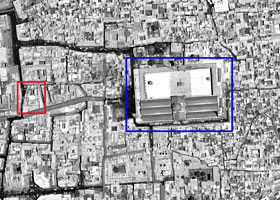Dar al-Hadith al-Ashrafiyyah
by someone
And in Dar al-Hadith there is a subtle meaning
On carpets where I incline and take refuge:
Perhaps I might touch with my very face
A spot touched by al-Nawawi's foot."
(Quoted
from al-Nawawi's successor Taqi al-din al-Subki in his Tabaqat
al-Shafi`iyyah al-Kubra, see GF Haddad: "Dar
al-Hadith al-Ashrafiyyah" [pdf]
The first Dar
al-Hadith was founded in Damascus by the Zengid ruler Nur al-Din
(al-Malik al-`Adil Nur al-Din Mahmud ibn Zanki (r. 662-671 H).
The Dar
al-Sunna school (subsequenty renamed Dar al-Hadith) was built with the
purpose of strengthening the sunni doctrine, a charge entrusted to Ibn
`Asakir, the erudite hadith scholar and historian of Damascus. It was
the first in its kind, later followed by
similar institutes, such as the Dar al-Hadith al-Kamiliyyah in Cairo
built in 728 H, where Ibn Hajar al-`Asqalani tought.
© Kultursällskapet
Damas 2006
The sandals of the
Prophet (s)
Prophet (s)
One of the merchants in Damascus had the honor to keep the shoes of Prophet Muhammad, peace and blessings be upon him. Following his will, the shoes were moved to Dar al Hadith after his death, where they were kept in a wooden box located above the mihrab of its mosque, as a goal of seekers of barakah from near and far. The shoes were lost when Dar al-Hadith was burnt by the tatars during the siege of Damascus in the 8th hijri century.

^
Mihrab of Dar al-Hadith
Photo: Ziarat mk/bmk 2007
Photo: Ziarat mk/bmk 2007
Imâm
Abû Hafs al-Fâkihânî (d. 734), a Maliki
faqîh and hadith master, visited Damascus seeking the baraka of
the the most honored Sandal of the Prophet (s), that was kept in a
wooden box above the Mihrâb in the mosque
of Dar al-Hadith . He bared his head and began to kiss it and
rub his face over it. His tears flowed. He recited:
Restoring Dar al-Hadith
In
the 13th
century H., a
Christian family resident in Damascus, who
owned the house next to the Dar al-Hadith Madrasah, laid hands on the
Western corner of the mosque and turned it into
a wine storage. Sheikh Yusuf al-Hasani al-Maghribi (d. 1279) took the
issue to the local land authorities, then to the Sultan of Istanbul -
all in vain. He then wrote and complained about the situation to his
friend al-Amir `Abdul
Qadir al-Jaza'iri (d. 1300 H). When the Amir came to settle in
Damascus in 1273 H., he purchased the building from
the Christians, restored it and endowed it as a waqf under the
supervision of Sheikh Yusuf and his descendants. The son of Sheikh
Yusuf, Sheikh Badru al-Din al-Hasani grew up in this house, and spent
his childhood
studying in Dar al-Hadith.
Dar
al-Hadith was burnt again
in 1912 during the uprising against the
French, and many of Sheikh Badru al-Din's books and hand-writings were
destroyed. The madrasa was rebuilt, however, the mosque pertaining to
it is
entirely destroyed except a portion of the
qibla wall containing the mihrab, which is incorporated in a private
residence.

^
Dar
al-Hadith is situated in
Asroniyyah district in Damascus city,
close to the East Gate of Saladin Castle. In the photo above Dar
Al-Hadith is shown in red square and Umayyad mosque in blue square.
(Source:
http://www.daralhadith.com)
Of those who were Heads of Dar Al Hadith:
| Sheikh Taqi al-Din ibn
al-Salah:
(577-643 H) Sheikh Imad al-Din al Harastani: (d. 662 H) Sheikh Abu Shamah: (599-665 H) Sheikh Imam Al Nawawi: (631-677 H) Sheikh Zain al-Din al Fariki: (d. 703 H) Sheikh Ibn al Wakeel: (665-716 H) Sheikh Al Zamalkani: (666-726 H) Sheikh Al Sharishi: (653-718 H) Sheikh Al Mazzi: (654-742 H) |
Sheikh Taqi Eddin Al
Sibki: (683-756 H) Sheikh Taj Aldeen Al Sibki: (Born 727-Died 771 H) Sheikh Abu Alfidda Ismail: (Born 701- 774 H) Sheikh Bahha Aldeen Alsubki: (707-777 H) Sheikh Wali Aldeen Alsubki: (735-785 H) Sheikh Zain Aldeen Alkorashi Almalahi: (724-792 H) Sheikh Shams Aldeen Aldimashki: (777-842 H) Sheikh Alaa Aldeen Alsayrafi: (778-844 H) |
References:
Tarikh `Ulama Dimashq
http://www.muhaddith.org/
© Kultursällskapet
Damas 2006